Staff Sgt. Joshua LeRoi
Vandenberg Space Force Base, California, has revolutionized West Coast space and test launch with an historic 51 launches in 2024 from the U.S. Space Force’s West Coast Spaceport and Test Range. This achievement was driven by the base's commitment to innovation, revising practices and procedures, and close partnerships with launch and test mission partners.
"This year marks a historic milestone for our nation's space launch capabilities, achieving a level of activity not seen in the past 50 years at Vandenberg," said Col. Mark Shoemaker, Space Launch Delta 30 commander. "As we accelerate our space launch efforts and push boundaries, we are rewriting the playbook of what is possible within the rules of the game."
The last time Vandenberg achieved this number of launches was in 1974.
Vandenberg SFB has modernized operations by implementing measures that focus on maximizing capacity, resilience, agility, and responsiveness. These efforts include optimizing the Day of Launch crewforce footprint, updating policies and integrating digital tools into operations. Through these initiatives, SLD 30 is reducing processing timelines and improving overall efficiency, enabling support for an increasing number of launches.
On June 17, 2024, an unarmed Mk21A re-entry vehicle (RV) was tested after being launched from Vandenberg aboard a Minotaur I rocket. The launch was an in-flight environmental test supporting the development of the Air Force's new Mk21A RV.
"Within just five years, our West Coast spaceport and test range has evolved from supporting four to six launches annually to executing more than 50 launches per year, transforming our operations to a high-capacity spaceport," Shoemaker said.
To achieve this launch cadence, SLD 30 has made significant progress in developing its architecture to improve launch readiness. The implementation of the Western Range Modernization Network and the transformation of the Western Range Operations Control Center are key components of maintaining a safe and effective spaceport. By supporting rapid range reconfiguration and modernizing weather data distribution, SLD 30 is ensuring that its spaceport operations are adaptable and responsive to the needs of the Department of Defense and mission partners.
On April 11, 2024, the first U.S. Space Force mission carrying Weather System Follow-on – Microwave (WSF-M) satellite launched aboard a SpaceX Falcon 9 rocket from Space Launch Complex 4-East at Vandenberg. This launch was the 13th mission from Vandenberg during 2024. The low-earth orbit space vehicle is capable of sensing, storing and transmitting microwave raw sensor data to enable derivation of ocean surface vector wind, tropical cyclone intensity, snow depth, soil moisture and sea ice characterization, supporting joint military operations and mission planning across the globe.
In 2024, SLD 30 implemented indirect charging as authorized by Congress to collect up to 30% of indirect costs related to direct costs from commercial space launch entities. The revenue generated by this process supported the base’s capacity and responsiveness improvements for launch activities.
Vandenberg Guardians and Airmen also supported three unarmed Minuteman III intercontinental ballistic missile test launches this year, with two of them occurring within a day of each other. As the primary ICBM test range, Vandenberg supports testing for this mission each year to ensure the capability is current and operational in defense of the nation.
As the number of launches continues to rise, Vandenberg Space Force Base is poised to remain at the forefront of the nation’s defense architecture and assuring access to space from the west coast.
"We are scaling our capacity and accelerating our space launch capabilities to meet national demands and maintain a competitive edge in the space domain," Shoemaker said. “I have no doubt that our skilled and dedicated workforce of civilians, military and contracted professionals will continue to build on our successes."




